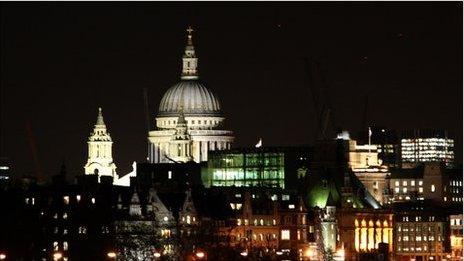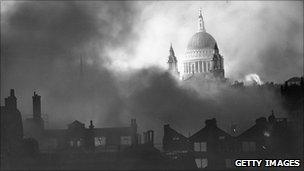St Paul's Cathedral marks 300th anniversary
- Published

The cathedral remains one of London's top attractions
From the the funerals of Lord Nelson and Winston Churchill to the royal wedding of Prince Charles and Lady Diana - St Paul's Cathedral has been the venue for some of London's most historic occasions.
This year marks the 300th anniversary of the completion of the beautiful cathedral, which has survived two world wars.
Prince Charles, a patron of St Paul's, attended the Royal Gala Concert on Thursday night which kicked off the celebrations.
Canon Michael Colclough, who has been at St Paul's for three years, said: "Although the concert was part of our 300th anniversary celebrations, it also marked the end of ten years in which we've raised and spent £40m restoring the cathedral.
"St Paul's is now looking certainly as clean and as brilliant as it was 300 years ago when Christopher Wren built it."
Ever since it was built, St Paul's has dominated the London skyline and continues to do so, despite the modern buildings that now surround it.
Londoners were reminded of the importance of Wren's masterpiece last year during the 70th anniversary of the Blitz.
Photographs depicting the World War II German air attack on the capital show how, while parts of London smouldered and were reduced to rubble, St Paul's remained untouched.
Canon Colclough said: "The very fact that it was not bombed during the Blitz in the Second World War made it a national symbol of resistance to the evil of Hitler."
A cathedral dedicated to St Paul has stood on the same site since 604AD.
Christopher Wren's 300-year-old masterpiece is the fourth one to have been built there.
Court architect Wren was commissioned by Charles II to build the cathedral after its predecessor was destroyed in the Great Fire of London in 1666.
'Decidedly dull'
It took Wren a decade to design the building and 40 years for it to be built.
The church architecture seen by Wren on a trip to Paris had inspired the design which included St Paul's impressive dome - the largest in the world at the time.

During the Blitz, prime minister Winston Churchill declared St Paul's must be saved
Canon Colclough believes that St Paul's may have in fact been finished earlier than the records show.
This is because the date of completion relates to Christmas Day 1711, when Wren was paid the final part of his salary.
Canon Colclough said: "The commissioners were holding back a certain amount of payment to make sure Wren finished the building. He appealed to the Archbishop of Canterbury and it went to Parliament.
"Parliament decided it was finished and forced them to pay Wren. It's arguable that the cathedral could actually have been finished in 1710."
More changes were made in the 19th century following a visit by Queen Victoria, who announced to the dean that the cathedral's interior looked 'decidedly dull'.
This resulted in the addition of the ornate mosaics at the east end of the cathedral. According to Canon Colclough, this was just the sort of thing Wren would have wanted to do but was not permitted to.
"St Paul's was the first cathedral built after the Reformation, and so they wanted it to be plain - they didn't want it to look Roman Catholic."
To this day, the cathedral remains one of London's major attractions and host to important state events.
In recent years the Queen has celebrated her Golden Jubilee and 80th birthday at St Paul's, and the public has mourned victims of the 7 July bombings at a memorial service.
For the Canon, the cathedral's pull is "the very strong cocktail" of architecture and music.
"People come in here and they're hit not only by the aesthetic of Wren's wonderful architecture, but also the very high standard of all the music we have here," he said.
"It's a great privilege for me to be working in that context."
- Published29 December 2010
- Published23 December 2010
- Published7 September 2010